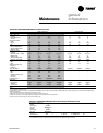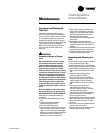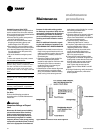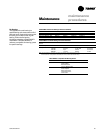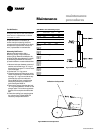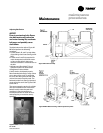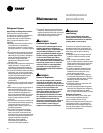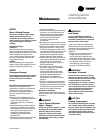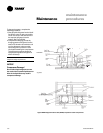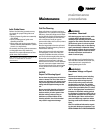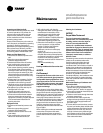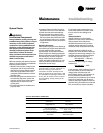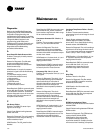
SCXG-SVX01B-EN 99
ƽƽ
ƽƽ
ƽ
WARNING
Leak Testing!
Do not exceed 200 psig when leak
testing system. Failure to follow these
instructions could result in an explosion
causing death or serious injury.
In the event of required system repair,
leak test the liquid line, evaporator coil,
and suction line at pressures dictated by
local codes, using the following
guidelines.
1. Charge enough refrigerant and dry
weight. Use an accurate scale or
charging cylinder to determine the
exact weight of the refrigerant entering
the system. Failure to use either a scale
or a charging cylinder can lead to
undercharging or overcharging
resulting in unreliable operation.
ƽƽ
ƽƽ
ƽWARNING
Hazardous Pressures!
If a heat source is required to raise the
tank pressure during removal of refriger-
ant from cylinders, use only warm water
or heat blankets to raise the tank
temperature. Do not exceed a tempera-
ture of 150°F. Do not under any circum-
stances apply direct flame to any portion
of the cylinder. Failure to follow these
safety precautions could result in a
violent explosion, which could result in
death or serious injury.
ƽƽ
ƽƽ
ƽCAUTION
Freezing Temperatures!
Do not allow liquid refrigerant to contact
skin. If it does, treat the injury similar to
frostbite. Slowly warm the affected area
with lukewarm water and seek immedi-
ate medical attention. Direct contact
with liquid refrigerant may cause minor
or moderate injury.
refrigerant containers.
• To minimize emissions while recovering
refrigerant, use recycling equipment.
Always attempt to use methods that
will pull the lowest possible system
vacuum while recovering and
condensing refrigerant into
containment.
• Be aware of any new leak test methods
that eliminate refrigerant as a trace gas.
• When cleaning system components or
parts, do not use CFC11 (R11) or CFC
113 (R113). Refrigeration system clean-
up methods using filters and dryers are
recommended. Do not use solvents
which have ozone depletion factors.
Properly dispose of used materials.
• Take extra care to properly maintain all
service equipment directly supporting
refrigerant service work such as
gauges, hoses, vacuum pumps, and
recycling equipment.
• Stay aware of unit enhancements,
conversion refrigerants, compatible
parts, and manufacturer’s
recommendations that will reduce
refrigerant emissions and increase
equipment operating efficiencies.
Follow specific manufacturer’s
guidelines for conversion of existing
systems.
• To assist in reducing power generation
emissions, always attempt to improve
equipment performance with improved
maintenance and operations that will
help conserve energy resources.
Refrigerant Leak Testing
It is important to follow all warnings and
cautions in this section when leak testing
equipment.
ƽƽ
ƽƽ
ƽWARNING
Use of Pressure Regulator -
Valves - Gauges!
Always use pressure regulators, valves,
and gauges to control drum and line
pressures when pressure testing
equipment. Failure to follow these
instructions could result in an explosion
causing death, serious injury, or equip-
ment damage.
NOTICE
Motor Winding Damage!
Do not use a megohm meter or apply
voltage greater than 50 DVC to a
compressor motor winding while it is
under a deep vacuum. Voltage sparkover
may cause damage to the motor
windings.
Refrigerant Charging
• R22 units
After leak testing and evacuating the
system, charge liquid refrigerant into the
system through the liquid line valve. After
some refrigerant has entered each
circuit, charge gaseous refrigerant into
the suction line shrader valve with the
compressors running.
• R407c
After leak testing and evacuating the
system, charge liquid refrigerant into the
system through the liquid line valve.
NOTICE
Compressor Damage!
Do not operate the compressors without
some refrigerant in each circuit. Failure
to do so may result in compressor
damage.
Special Note on Refrigerant Emissions
Follow the Trane recommended
procedures on operation, maintenance,
and service to endure refrigerant
conservation and emission reduction.
Also, pay specific attention to the
following:
• When removing refrigerant from air
conditioning or refrigerating equipment
recover for reuse, recycling,
reprocessing (reclaim), or properly
destroy it.
• Always determine possible refrigerant
recycling or reclaiming requirements
before beginning recovery. Questions
about recovered refrigerants and
acceptable refrigerant quality
standards are addressed in ARI
Standard 700.
• Use approved containment vessels and
safety standards when shipping
Maintenance
maintenance
procedures



